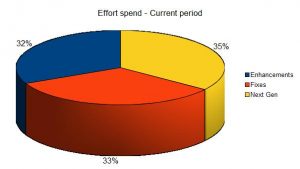You are a manager for a team that is working on a Product. Your fairly large team, is responsible for:
- adding features
- providing fixes to existing issues
- working on a new architecture
You have to deal with three different stakeholders for these three initiatives and send them updates on a weekly basis. You find that you are lagging behind on the new architecture initiative. You decide to dedicate two half days of the week, of the entire team for working on this.
Things are going well, but off late you notice that the two stakeholders responsible for the support and enhancing the features are acting strangely. They seem to want more frequent updates, insinuate that you are neglecting their needs, escalate trivial issues to your Director.
You learn that, a junior team member inadvertently shared with the stakeholder who is responsible for support, his work on the new architecture as a reason for not starting work on a critical fix. There was however no breach in the SLA for the bug fix time. It was completed within the agreed norm.
Now you know a possible trigger, how would you deal with it?
Suggested solution:
The trigger was an inadvertent communication of your internal workings of the team causing one of the stakeholders to suspect that his work is given lesser focus. Quite possibly he has shared that with another stakeholder, who he thinks may be impacted in a similar way. There could be other interpersonal and inter department issues, we need to be aware of that, we may not have any control over it.
Communication is what one needs to focus on. Regular communication in form of status reports and calls may be in place, a review of the same would help.
To do that one could do a quick Stakeholder Analysis, look at the stakeholder’s needs and concerns. Then work out how to address this in existing or new communication. Here the key issue is the expectations from a shared team. The shared team has been set up to work towards the organization goals, the efforts should be aligned with the goals and transparent to all.

If they need to make any changes in that they could get together and make required changes for the upcoming periods. 
Sharing of data, transparency and understanding of Stakeholders needs will always help one deal with situations involving multiple stakeholders.
